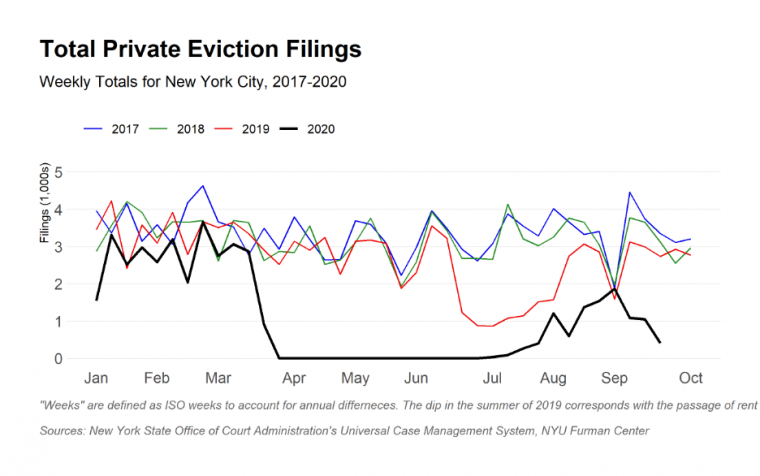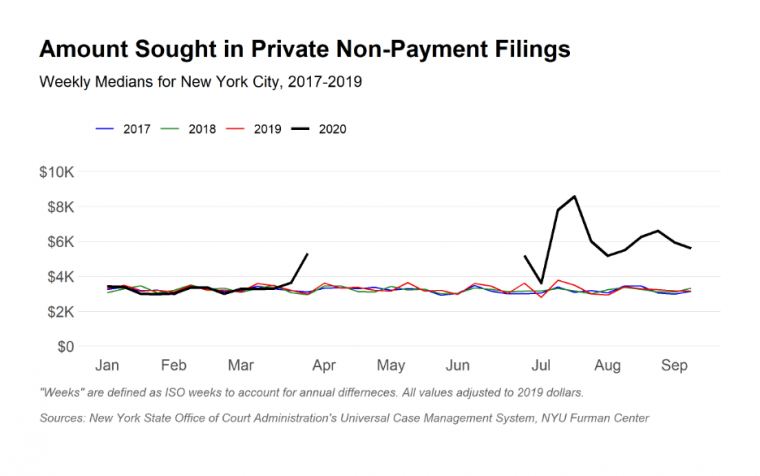
Data Update: Eviction Filings in NYC Since COVID-19

The economic fallout from COVID-19 has led to fears of a “tsunami” of eviction filings, with an estimated 735,000 households having lost employment income in New York City as of early June. In this post, we summarize key data that provide insights into recent trends in eviction filings in New York City housing courts. Since March, a combination of federal, state, and local orders has limited the eviction process, and prevented the worst-case scenario thus far. Nevertheless, there has been some activity in housing court. Below, we discuss the volume and the nature of recent eviction filings in New York City.
On March 20, Governor Cuomo issued, by executive order, a 90-day moratorium on evictions. Pursuant to the executive order, the New York State Office of Court Administration directed housing courts not to accept new eviction filings between March 20 and June 20. In an ordinary year, housing courts would receive approximately 39,000 filings during this period.
After the Governor’s moratorium expired on June 20, housing courts began accepting new eviction filings. Between June 20 and September 20 of this year, 9,934 private (i.e., non-NYCHA) eviction cases were filed in NYC housing courts, which would normally see around 38,000 filings during this period. All in all, in a typical year we would have expected to observe a total of 77,000 eviction filings between mid-March and mid-September and, so far, have seen 10,000.

A series of government orders limiting landlords’ abilities to evict tenants helps to explain the decrease in eviction filings despite the economic effects of the pandemic. First, although housing courts are now accepting new eviction filings, all new cases are automatically suspended—meaning that no hearings are scheduled, and therefore no eviction warrants can be issued. Meanwhile, housing courts only began to hold hearings for eviction cases filed before the pandemic at the end of July, and resolving these cases can take months, if not years. The execution of eviction warrants in cases where a judgment has been reached has been delayed until at least January 1, 2021.
Second, the Tenant Safe Harbor Act, signed into law by Governor Cuomo on June 30, prevents landlords from filing to evict tenants who suffered a financial hardship during the pandemic for non-payment of rent (instead, a landlord can seek money judgment for the rent owed). Finally, the federal Centers for Disease Control and Prevention (CDC) issued an order providing income eligible-tenants with the ability to seek protections from non-payment eviction filings through the end of 2020.

The cases that have been filed this year are also different from previous years’ filings. As shown in the figure above, the median amount sought in non-payment cases filed since June is higher than the median sought in prior years, in some instances rising to more than twice the median of prior years. This higher amount sought could be due to several factors, including: larger rental arrears that accumulated during the shutdown; tenants’ with higher rents receiving eviction filings; or landlords’ delaying filing for cases with lower amounts sought. The spatial distribution of eviction filings since June 20 also differs from the typical distribution. Whereas filings are usually concentrated in the Bronx and southern Queens, this year Corona (Queens, ZIP Code 11368) has both the highest eviction filing rate (2.94 filings/100 private rental units) and the most filings overall (617). Notably, Corona is among the New York City neighborhood hardest hit by COVID-19.

For future eviction filing updates delivered directly to your inbox, sign up for the Furman Center's Data Updates list.



